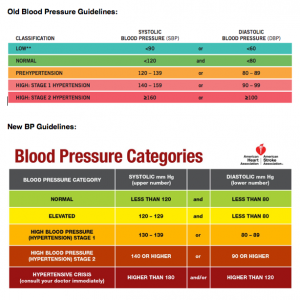YOU have been diagnosed with hypertension, which according to the conventionally accepted parameters means that your BP readings (as of the guideline changes of Nov) are greater than 130/80 mmHg - where the first number represents the SYSTOLIC reading (pressure against artery walls when the heart contracts) and the second number the DIASTOLIC (pressure when the heart chambers are filling with blood).
See chart below for more detailed info on BP ranges: (recently Nov updated ranges now shown)
So, like a trooper you decide to tackle this issue yourself by looking at natural approaches to lowering your BP. This will include ushering in some important lifestyle changes, such as changing your diet, quitting smoking (if you are a smoker, that is!) and getting more exercise. If you are overweight, you will have to make efforts to lose those unwanted pounds, and you also need to take a good look at how you are managing the everyday stresses in your life.
And, having committed to these changes, over time you see some improvements in your BP readings. But they leave you hovering in the prehypertensive range which will still get you a raised eyebrow from the Doctor next time you see him - and the possibility that he will recommend you start on blood pressure medication.
But, hang on a moment! Before you accede to what seems to be the inevitable and acquiesce to taking medications, which you will likely be expected to be on for the remainder of your life, have you considered something which is not commonly associated with developing high blood pressure?
Namely HEAVY METAL TOXICITY and the need to DETOX to lower blood pressure.
What is Heavy Metal Toxicity?
The National Organization for Rare Disorders lists on its webpage 23 different metals which may contribute to heavy metal toxicity build up in the body. For the complete list of these check the website here.
The presence of excessive amounts of any of metals on this list of 23 heavy metals can potentially lead to serious health problems, however the 4 which are most commonly indicated in human heavy metal toxicity are:
- lead
- mercury
- arsenic
- cadmium.
… and each of these can play a role in contributing to HYPERTENSION.
LEAD used to be found everywhere because it was an ingredient in paint, including children’s toys, and in the gas we used to pump into our cars.  Thankfully, this is not so common anymore due to legislative processes in our countries, but lead is still used in products imported from other parts of the globe, such as China.
Thankfully, this is not so common anymore due to legislative processes in our countries, but lead is still used in products imported from other parts of the globe, such as China.
It is also be present in the older lead pipes used for conveying household water. And it can build up over the years, being stored in our bones in a dormant state. However, as we age and our bones become less dense, the lead escapes back into the body.
Post-menopausal women were found in a study published in the Journal of the American Medical Association to be at the most risk, due to thinning of the bones and the subsequent leaching of stored lead back into the body, where one side effect ended up being high blood pressure.
Expectant women are also vulnerable, as the demineralization of the bones which happens during pregnancy can lead to the fetus being exposed to high levels of lead, too!
MERCURY of course is still widely found in silver mercury amalgam fillings.
The World Health Organization (WHO) has estimated that silver-mercury fillings are the main source of exposure to mercury in humans, The effects of mercury toxicity in the body include three elements which are contributing factors to high blood pressure, namely:
- oxidative stress
- inflammation
- blood vessel abnormalities and damage
Mercury toxicity may lead to kidney disease which has also been linked to high blood pressure.
Note: Yet another way that mercury can enter the body is via the food we eat, such as certain types of larger fish species, e.g. salmon which have been contaminated in the heavily polluted oceans where they spent their lives.
ARSENIC - Once the poison of choice in murder Whodunnit? novels, this is a toxin which can be found in drinking water, especially from deep wells, and is used widely in the manufacture of pesticides.
It is also released into the air through industrial processes such a mining, fossil fuel burning and metal smelting. This leads to contamination of the air, our water supply and the soil. Granted one side effect of arsenic toxicity may be hypotension, however studies have also uncovered a link between exposure to arsenic and the prevalence of hypertension.
CADMIUM - One main source of Cadmium is to be found in phosphate fertilizers which when applied gets into the ground where it enters the food chain through the plants absorbing it from the soil. Crops such as cereal grains, rice and potatoes take Cadmium up more readily than other plants.
Cadmium toxicity can negatively affect the kidneys, causing a condition called Renal Tubular Dysfunction/Acidosis. This condition then affects kidney function which negatively impacts blood pressure. A study of just over 1900 Korean test subjects who had been exposed to Cadmium found that the blood pressure levels of those participants in the study who had higher levels of blood Cadmium were significantly affected. This was especially true in those cases where kidney function was compromised, thus suggesting that:
“Cadmium exposures at the current level may have increased the blood pressure of Korean general population.”
How to Check for Heavy Metal Toxicity
In this section I am going to touch on the different methods of testing for Heavy Metal Toxicity. I cannot recommend one way over another, since I don’t have the expertise necessary. What is interesting is that certain practitioners will have their preferred methods of testing. This will differ from say how a Naturopath approaches the issue to how a Doctor/Specialist, whose area of expertise is dealing with Chronic Fatigue Syndrome, does.
The following are most commonly used for testing heavy metal toxicity.
- Urine tests - including (a) urine metal challenge and (b) urine porphyrin tests
- Hair Anaysis
- RBC Mineral test
From my research these tests appear to be the ones most commonly recommended by practitioners. Each one has its limitations, but when used in concert with one (or more) of the others they do give a good overall picture of what is going on.
Looking in a little more detail at each test…
Urine metal challenge test. Here the heavy metals are measured by means of taking a urine sample. Then a heavy metal chelation compound is introduced which the heavy metals will bind to as it passes through the body. Further urine tests are then taken. This is a procedure which needs to be ordered by a Doctor and is relatively expensive. Also some people can become quite unwell due to the chelating effect of releasing dormant heavy metal elements into the body. But it is considered to be an accurate indicator of heavy metal toxicity.
Urine porphyrin test. Porphyrins are metabolites found in the production of hemoglobin. Since the presence of certain toxic metals can disrupt the process, this causes some metabolites to be excreted in the urine. Thus, this test is gives a good overall impression of how much toxicity the body is subject to.
Hair Anaysis. This test is a quick and convenient way to tell how much heavy metal is being stored in the fat, the tissues, the organs and the cells of the body. It consists of providing a hair sample, and you can buy an inexpensive kit which may be then sent away for analysis. Not all experts agree on the efficacy of this test, however. The main objection is that the hair test may not reflect completely how much toxin is in the body because the body is storing the toxin and not able to release it through the hair. So, this test is probably not the best one to use, especially not on its own!
RBC Mineral test. The Red Blood Count test will indicate whether or not there has been recent or continuing exposure to heavy metals. But it is not such a reliable tool for showing if there are heavy metals stored in the fat, tissues, organs or cells. So again this test should ideally be used in concert with one, or more of the other tests.
My advice here is to consult with a qualified practitioner when it comes to choosing which tests should be run to assess for heavy metal toxicity.
And now for Detoxing:
Having got your results, the next stage is to find the right heavy metal toxicity treatment. Ideally, you want to be able to detoxify and remove the harmful toxic build up in your body.
The most accepted way in the medical world to date is through the use of Intravenous Chelation Treatment.
To my way of thinking this would be a good option if you have been diagnosed with chronic heavy metal toxicity, since it really is like bringing out the heavy artillery to deal with the problem and it is very effective.
However, it is expensive and it needs to be very carefully supervised by a medical professional, since the release of toxins into the bloodstream stimulated by the chelation treatment can cause patients to feel quit ill, and if not done properly can overload the liver and kidneys, as they attempt to eliminate the harmful toxins.
So, what about less radical treatments, especially if the level of toxicity is not considered chronic? Well Oral Chelation is also another approach. This is generally less severe on the body, does produce results but usually over a longer period of time. It does have side effects as well, so needs to be approached with caution, and again with the input of a medical professional.
There are other more natural ways to detoxify which will work, even with heavy metals, but will likely take longer to have the desired results. But because they are natural treatments they offer an excellent choice for ongoing gentle detoxification
In Conclusion
There is no doubt that we all are exposed to some level of heavy metal toxicity every day. It’s in the air we breathe, in the pollution in our cities, in our soil and in our water supplies. And it is also present in small but accumulative amounts in some foods that we eat. In short, there is no getting away from it! So, it is crucial to be aware of the importance of detoxifying the body and how it can help us maintain optimum health.
And to return to the original question: Is heavy metal toxicity driving up your BP?
Yes, it certainly could be a contributory factor, especially if you have already made changes in your lifestyle to address the other common causes underlying high blood pressure, and you are still struggling to manage your blood pressure.
I believe it would certainly wouldn’t do any harm have it checked out, and who knows it may make all the difference!
What do you think? Please let me know in the comments section below.

